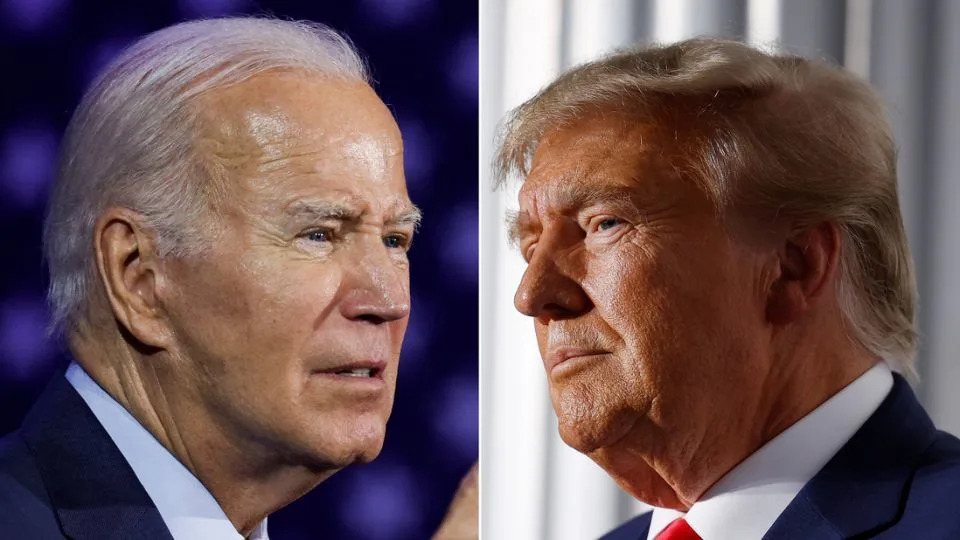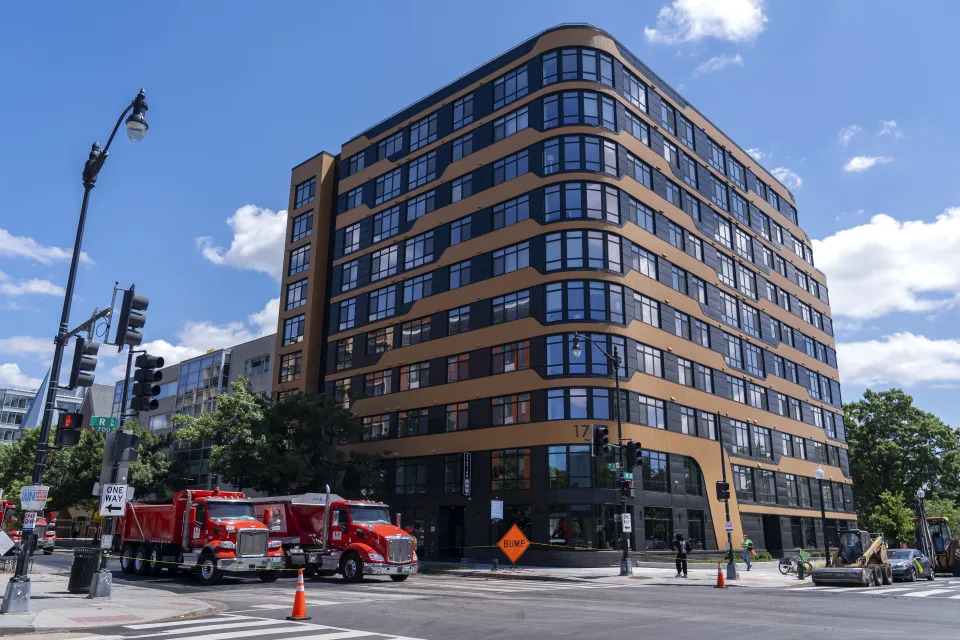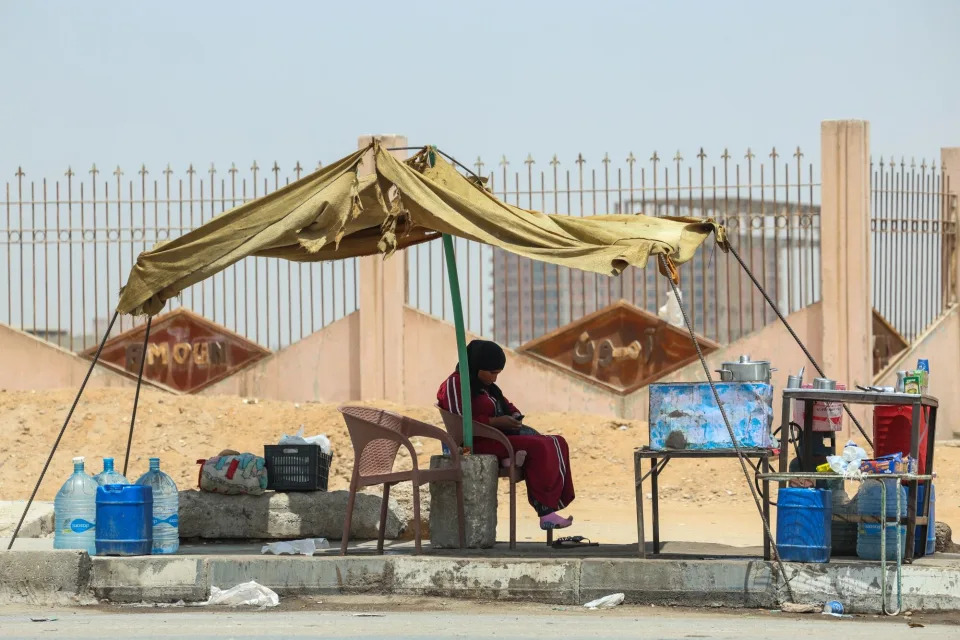AMERIKA
Young men and women are diverging politically. That could shape the 2024 election.
Analysis by Ronald Brownstein, CNN
Mon, June 10, 2024

Democrats are facing the threat of a gender gap that could imperil the traditional advantage among younger voters that the party has enjoyed for decades and that President Joe Biden likely needs to defeat former President Donald Trump.
While Democrats are counting on a big backlash among younger women against the rollback of abortion rights to help propel Biden, a backlash among younger men against changing gender roles could help lift Trump.
Both younger men and women are broadly discontented with the economy and Biden’s job performance, polls show. But the anger and frustration over the 2022 Supreme Court decision overturning the federal right to abortion provides Biden a powerful tool to expand his support among young women unhappy with him on other fronts, strategists in both parties agree. For many younger women, pollsters say, the loss of abortion rights has become not only a threat in itself, but a symbol of a broader attempt to reverse women’s gains in economic status and pressure them back into more traditional gender roles.
Meanwhile, Biden faces a dual challenge with younger men: Not only is abortion less of a motivating issue for them, but there’s evidence that many of them are receptive to the messaging of Trump’s “Make America Great Again” movement, with its implicit promise to restore traditional racial and gender hierarchies. In a striking new Pew Research Center national survey, for instance, fully two-fifths of the men younger than 50 who are supporting Trump agreed that women’s gains in society have come at the expense of men. That was not only more than double the share of younger Biden-supporting men who agreed with that sentiment, but considerably larger even than the share of older Trump-supporting men who agreed.
All this suggests that while cultural attitudes may help Biden overcome economic discontent among younger women, an amorphous but insistent sense of cultural marginalization may reinforce Trump’s economic inroads among younger men.
Researchers say democracies across the Western world are experiencing a widening partisan and ideological gap between younger men and women. In a much discussed article earlier this year, Financial Times columnist John Burn-Murdoch pointed to survey data in a variety of countries showing that young men were far more likely to identify as conservative than young women. “In countries on every continent, an ideological gap has opened up between young men and women,” he wrote.
That gap has widened in the US, too, though the evidence shows that it is growing more because young women are ideologically moving to the left than because young men are moving to the right. Merged annual results from NBC polls conducted by a bipartisan team of Democratic and Republican pollsters document the trends.
In 2013, the share of young men aged 18-29 who called themselves conservative very slightly exceeded the share who identified as liberal, while the reverse was true for young women, according to results provided by Public Opinion Strategies, the GOP half of the partnership that conducts the NBC poll. For each gender, though, the balance between conservatives and liberals was nearly even.
In their 2023 results, the pollsters found that young men had shifted slightly left, with slightly more now identifying as liberal than conservative. But, over that same 10-year period, young women had sped leftward: In the 2023 results, three times as many of them identified as liberal than as conservative. In 2013, the share of self-identified liberals among young women exceeded the share among young men by 5 percentage points; by 2023, that gap was nearly four times as large.
These shifts over time have produced a situation where younger men are still more liberal than older men on most issues, but not nearly as liberal as younger women. The annual youth poll conducted by the Institute of Politics at Harvard University’s John F. Kennedy school offers perhaps the best snapshot on the gender divergence among younger adults.
In this year’s survey, young men were 15 points more likely than young women to support building Trump’s border wall, 12 points more likely to say same-sex relationships are morally wrong and 11 points more likely to say Israel’s response to Hamas in Gaza has been justified. Still, in each case, only a minority of younger men endorsed those conservative viewpoints.
But while younger men have moved only modestly to the right on most public policy issues, they have more clearly shifted in their willingness to identify with the Republican Party. The latest annual Harvard youth survey found that among young men, Democrats now only have a 3-percentage point advantage in party identification, down from 22 points as recently as 2020. Among women, the Democratic identification edge over that same period grew from 20 to 26 percentage points. (The NBC surveys likewise found the Democratic advantage narrowing among younger men and widening among younger women over recent years, though the changes were not as dramatic as in the Harvard poll.)
“There is not a ton of evidence that young men are more likely to identify as conservatives, but there does seem to be a growing affinity for Republican identity,” said Daniel Cox, director of the Survey Center on American Life at the conservative American Enterprise Institute.
That growing receptivity to the GOP could contribute to a wider gender gap among young people than in recent elections. The latest Harvard poll showed that among likely younger voters, Biden led Trump by about 2-to-1 among women, almost exactly his advantage in the Harvard Poll at this point in 2020. But among likely male voters, the survey found that Biden led Trump by just 6 points, a precipitous, and perilous, decline from his 26-point advantage in the 2020 survey at this point.
Other respected sources on voting results in 2020, such as the exit polls, found that Biden didn’t win young men that year by as much as Harvard projected, which would mean his decline now is less severe. Still, pollsters in both parties say their own data track the same movement the Harvard poll identifies, with Biden largely holding his lead from 2020 among younger women, but slipping among younger men, including not only White but Black and Latino younger men.
The good news for Biden is that younger women turned out at much higher rates than younger men in 2020; in fact, the gap between female and male turnout that year was wider for younger adults than in any other age group, according to analysis of Census Bureau data by William Frey, a demographer at the Brookings Metro thinktank. But Biden has so little margin for error in the battleground states that the level of erosion among younger men that he’s experiencing in polls still poses a grave threat to his reelection.
In explaining the growing youth gender gap, analysts point to several factors. One is diverging priorities between young men and women. Even more young women in the Harvard youth poll expressed negative views about Biden’s economic record than young men did, but the women were far more likely than the men to cite abortion as a key factor in their vote. “The difference is young women are voting more on culture and rights, such as abortion, and young men are probably going to be more compelled to vote on economic reasons,” said Melissa Deckman, CEO of the non-partisan Public Religion Research Institute and author of the forthcoming book, “The Politics of Gen Z: How the Youngest Voters Will Shape our Democracy.”
As with all generations, Trump’s belligerent style also contributes to the widening gender divide. “Younger men admire the strength of Trump, but what younger men think is strong, women think is chaotic, crazy and divisive,” said Democratic pollster Celinda Lake, who polled for Biden’s 2020 campaign.
Trump also has a significant tactical advantage in that he tends to be portrayed much more positively than Biden on the YouTube channels, podcasts, Reddit threads and TikTok videos that constitute the principal source of information for many young men, noted John Della Volpe, who directs the Harvard youth poll. (In that survey, young men were substantially more likely than young women to say they rely on YouTube as a major source of news.) “The media ecosystem specifically among young men is [a place] where Joe Biden doesn’t get a break and Trump is stood up as an anti-hero,” said Della Volpe, who is advising a newly formed super PAC trying to boost Biden among young people. Trump has leaned into that advantage by identifying with entertainment that disproportionately draws younger men, like the Ultimate Fighting Championship match he attended as his first public event following his felony conviction in New York.
Trump may also be drawing from deeper wells of changing social attitudes. Last week’s Pew finding that two-fifths of younger males backing Trump believe women’s gains have come at men’s expense is only one of many recent poll results suggesting more young men are bristling against the rising demands for gender and racial equity.
The new Pew poll, for instance, also found that more than four-fifths of the younger men supporting Trump asserted that all the obstacles blocking women’s advancement in society have been eliminated — more than double the share of Biden-supporting younger men who agreed. (In this case, older men backing Trump were as likely to endorse that statement as younger ones.) Nearly two-thirds of the younger men supporting Trump also agreed in the poll that “society is better off if people make marriage and having children a priority” — equal to the share of older Trump men and more than triple the share of younger Biden men. In an AEI poll this spring, the share of all young men who say efforts to promote gender equity have gone too far reached about 1-in-5, more than double the level in 2017.
Survey evidence also shows resistance, particularly among younger White men, to the growing demands from minority groups for more racial equity in education, employment and other settings. In that same AEI poll, over three-fifths of young White women said their race has made their life easier, but far fewer young White men said the same (only about 2-in-5). Conversely, in this year’s Harvard poll, nearly three-fifths of men (of all races) agreed that society is placing too much emphasis on racial identity; only about two-fifths of young women agreed. Exactly three-fourths of younger men supporting Trump in the Pew poll rejected the idea that Whites benefit from advantages in society unavailable to Blacks.
This backlash against a changing society only extends so far: Though the “tradwife” movement in social media celebrates women reverting to roles as homemakers and mothers, in the Harvard Poll only about 1-in-6 younger men (and 1-in-10 younger women) agreed that women should prioritize having children over entering the workforce. Deckman noted that compared to older generations, young men today “have been raised by their mothers and aunts and grandmothers, who have gone on to hold jobs and be professionals and they are used to seeing women as leaders.”
But if young men aren’t moving back to 1950s expectations in large numbers, the surveys showing male unease with women’s increasing independence and authority make clear that something is stirring. “Looking across different surveys and different questions, we can debate about the degree to which it is changing, but there is no doubt we are seeing movement,” said Cox of the AEI.
This pushback among young men comes after activism around racial and gender equality in the past few years reached its highest level since the late 1960s and early 1970s, with the rise of the #MeToo and Black Lives Matter movements and more forceful advocacy in LGBTQ communities. (In the Harvard poll, one-fourth of young women identified in some way as LGBTQ, more than double the share of young men.) It also comes amid continuing evidence that women are navigating the transition to an information-based economy better than men: Women now account for about 60% of all four-year college graduates and nearly 65% of graduate degrees, according to the latest federal statistics.
In her upcoming book, Deckman sees the #MeToo movement as the galvanizing force initially propelling more Gen Z women toward liberal activism. That first impulse, she said, has been reinforced by Trump’s 2016 electoral success, despite his extensive history of misogynistic statements and behavior. The sharp turn right on social issues in red states, punctuated by the Supreme Court’s 2022 Dobbs decision overturning the nationwide right to abortion, has provided another spur to activism.
Anna Dean, co-founder and co-CEO of the group LOUDwomen, is one of the young female activists Deckman profiles in her book. Dean, now a rising senior at Harvard, helped to start the group in high school in Bentonville, Arkansas, when she noticed that young women and racial minorities were dropping out of school debate activity after biased treatment by the judges. When Trump was elected, she said, the young women felt the same sexist or racist behavior they were fighting in their schools was “reflected on the news when we hear Donald Trump speak.” The Dobbs decision, she said, underlined the sense among the young women that their rights were eroding, even as many of them had reached educational milestones unmatched for older women in their families.
When relatives or acquaintances tell Dean she is living the “wildest dreams” of earlier generations of women by attending Harvard, she said she often thinks: “OK, yeah this is awesome but at the same time I don’t have the same rights you did when you were my age. I am doing things my ancestors could have only dreamed of, but at the same time I don’t have the same health care rights.”
Della Volpe says that from his research and focus groups, he believes that younger men are not so much hostile to the movements demanding more rights for women or LGBTQ people as wondering where that leaves them. “I have empathy for them because in large measure they are just trying to figure life out,” he said. “And they sense and feel, sometimes accurately, sometimes inaccurately, that while they are trying to figure life out that they are being judged by people — that they are projected to be inferior or bad or ignorant, or worse, racist or homophobic. I think that’s a big part of this.”
Such anxieties and grievances about social change have always provided the waters that Trump fishes in. The ability to identify the currents of discontent about change — cultural, racial or economic — in each group that he is targeting may be Trump’s greatest skill as a politician. Just as the former president has powerfully appealed to White voters who feel marginalized in a more racially diverse America, or to blue-collar factory towns that feel left behind by the transition to a metro-based information economy, he’s also showing a magnetic pull for the men who feel eclipsed by women’s growing prominence in the workplace and society.
Most younger men don’t necessarily hold favorable views about Trump personally, noted Cox, but many are receptive to his broad message that elites in modern US society are discriminating against him and his followers. “That grievance is what binds them [to him] when very little else does,” Cox said.
By contrast, said Deckman, for younger women who believe opportunity and power in US society are still too much tilted toward men, “Donald Trump is the embodiment of many of the things they are opposed to. … They are sick of old White guys running everything.”
That sentiment doesn’t easily translate into enthusiasm for Biden, the other “old White guy” in the race. Dean said that despite the distaste for Trump, even young women in her activist circles are more likely to talk about their frustrations with the current president than their fears of the prior one.
Given the risk that Biden won’t match his 2020 performance with young men, he has an urgent need to rekindle that flagging enthusiasm among young women. “He’s got to make up for the defection of young men by winning young women by more, and he’s got to get every young woman he can out to vote,” said Lake, the Democratic pollster.
Biden’s best hope of avoiding a catastrophic decline in his youth support is that the number of young women Trump repels exceeds the number of young men he attracts.
For more CNN news and newsletters create an account at CNN.com
















